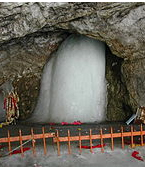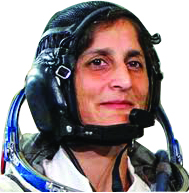 India is recognised as the land of temples. Temples in India are so famous that tourism is the mainstay of income where temples in India map the geography. Indian temples are thronged by pilgrims and visitors owing to the rich heritage and cultural significance these Indian temples carry. To understand our rich culture and heritage we are going to take you all to a visual journey of renowned temples of Bharat. In this issue we will be travelling in the picturesque Valley of Jammu & Kashmir.
India is recognised as the land of temples. Temples in India are so famous that tourism is the mainstay of income where temples in India map the geography. Indian temples are thronged by pilgrims and visitors owing to the rich heritage and cultural significance these Indian temples carry. To understand our rich culture and heritage we are going to take you all to a visual journey of renowned temples of Bharat. In this issue we will be travelling in the picturesque Valley of Jammu & Kashmir.
Shankaracharya Temple
The sacred temple of Shankaracharya occupies the top of the hills known as Takht-i-Sulaiman in the south-east of Srinagar. The site dates back to 250 BC. Shankaracharya stayed at this place when he visited Kashmir ten centuries ago to revive Sanatan Dharma.
Martand Temple
Martand, located atop a plateau, close to the township of Anantnag, has a temple dedicated to Surya, the ‘Sun God’. Built by king Laitaditya Muktapida (7th to 8th century AD), it is a medieval temple with a colonnaded courtyard and the shrine in its centre.
Kheer Bhawani
The Goddess Ragnya Devi is symbolised as a sacred spring at Tula Mula village, 27 kms from Srinagar. Within the spring is a small marble temple. The temple-spring complex is affectionately known as Kheer Bhawani because of the thousands of devotees who offer milk and kheer to the sacred spring, which magically changes colours to warn of disaster.
Krimchi Temple
About 74 kms from Jammu via Udhampur are the famous Krimchi temple ruins characteristics of the early medieval temple architecture. The carvings on the ancient temple provide ample testimony, of the perfection in craftsmanship archived by people in such hilly and remote areas of Jammu and Kashmir. According to a legend ‘Pandvas’ had built the temples.
Ancient Temple, Babor Temples
About 75 Kms to the east of Jammu city, ‘Babor’ is a place for archeologists, historians, and tourists who want to see some thing striking in the art of temple architecture and sculpture. Only five Babor temples are now standing in ruined state while many others have completely crumbled down.
Raghunath Temple
Situated in the heart of the Jammu city and surrounded by a group of other temples, this temple, dedicated to Sri Ram, is outstanding and unique in northern India. Work on its construction was started by Maharaja Gulab Singh, founder of the principality of Jammu and Kashmir, in 1835 AD and was completed by his son, Maharaja Ranbir Singh, in 1860 AD.
Ranbireshwar Temple
Built by Maharaja Ranbir Singh in 1883 AD, this historic temple is dedicated to Lord Shiva. It has one central ‘linga’ measuring seven-and-a-half ft in height, twelve Shiva ‘lings’ of crystal measuring from 15″ to 38″ and galleries with thousands of others carved on stone slabs.
Panchvaktar Temple
This temple is considered one of the oldest in Jammu and is linked to the visit to Jammu of the Shankaracharya in the ninth century AD, when he was on way to Kashmir. It is considered sacred because of the self-originated Shivling.
Mahamaya Temple
The ancient Mahamaya temple overlooking the river Tawi is dedicated to Mahamaya, a Dogra Queen who lost her life fourteen centuries ago fighting foreign invaders.
Purmandal-Uttar Behni
Purmandal located at a distance of 40 kms from Jammu is a temple complex devoted to Lord Shiva. Also known as Chhota Kashi it is located on the banks of the Devak the underground river. At a distance of 4 kms from Purmandal is the village of Uttar Behni called so as the river Devak takes a northward turn something rare for rivers in the Himalayan foothills.
Sudh-Mahadev
This highly revered Shiva temple (1,225 meters) is located at a distance of 42 Kms from Patnitop and 112 Kms from Jammu. Legend has it that after bathing at a spring called Gouri Kund, just short of Sudh Mahadev, the Goddess Parvati would worship the Shivling here that is believed to be at least 3,000 years old. The temple also houses a black marble statue of Lord Shiva and Parvati. A trishul (trident) of Lord Shiva is also preserved here. The mystical underground stream Devak believed to be as sacred as the Ganges originates at Sudh Mahadev and disappears among the rocks some distance downstream.
Mantalai Temple
A few kilometers further ahead of Sudh Mahadev is Mantalai (1450 meters) surrounded by lush deodar forests. As per legend, it is the place where Lord Shiva got married to Goddess Parvati.
Kali Mata Mandir
While returning to Jammu one can visit the Kali Mata Mandir, located next to a waterfall near Manthal, 40 Kms from Jammu.
Peer Khoh
Peer Khoh is a cave shrine located on the Circular Road, 3.5 kms from the heart of the town. There is a naturally formed Shivling in the cave which is quite mysterious as neither its antiquity nor its cause are known. Legend has it that the cave leads underground to many other cave shrines.
Amarnath
Amarnath cave is a very famous shrine in Hinduism located in Jammu and Kashmir . It is dedicated to Lord Shiva. Amarnath shrine is considered to be one of the holiest shrines in Hinduism. Most time of the year the cave is covered with snow except for a short period of time in summer when it is open for pilgrims.
People come here to see an ice stalagmite (the Linga)formed inside the cave. It is considered to be a Shivling by devout Hindus. As per the religious beliefs, it has been claimed that the Shivling grows and shrinks with the phases of the moon reaching its height during the summer festival.
According to a Hindu legend, this is the cave where Shiva explained the secret of life and eternity to his divine consort, Parvati. Two other ice formations represent Parvati and Shiva’s son, Ganesha.
Katra and Mata Vaishno Devi
The Katra town is located 52 kms from Jammu.It is one of the most popular pilgrim destinations for Hindus the world over as it is the base camp for the pilgrimage to the holy shrine of Mata Vaishnodevi in the famed Trikuta Mountains in the Shivalik Range. Visited by nearly 8 million pilgrims the holy cave of Mata Vaishno Devi is at a distance of 13 kms from Katra.
Shiv Khori
This is one of the most venerated cave-shrines of Lord Shiva in the region. The cave is formed in the shape of Lord Shiva’s damroo i.e. wider at the two ends and narrow at the centre. The presence of naturally formed figurines of the deities adds to the religious significance of the holy cave.
Buddha Amarnath Shrine
Buddha Amarnath, located amongst picturesque surroundings in the border district of Poonch in Jammu region is a shrine of Lord Shiva, considered to be second only to the shrine of Shri Amarnathji in its religious significance. An annual 10-day yatra to this shrine takes place from Jammu during the month of August-September every year.
—Aniket Raja
(Inputs from J&K Tourism)
Sunita Williams Pandya
Second women of Indian origin to have gone on a NASA mission
 Sunita Williams Pandya is the second woman of Indian origin to have gone on a NASA space mission after Kalpana Chawla. Born on September 19, 1965 to Dr Deepak and Bonnie Pandya at Ohio in the US, she holds three records for female space travelers, longest space flight (195 days) number of space walks (four) and total time spent on space walks (29) hours and 17 minutes).
Sunita Williams Pandya is the second woman of Indian origin to have gone on a NASA space mission after Kalpana Chawla. Born on September 19, 1965 to Dr Deepak and Bonnie Pandya at Ohio in the US, she holds three records for female space travelers, longest space flight (195 days) number of space walks (four) and total time spent on space walks (29) hours and 17 minutes).
Williams’s roots on her father’s side go back to Gujarat in India and she has been to India to visit her father’s family. As for her education, Williams attended Needham High School in Needham, Massachusetts, graduating in 1983. She went on to receive a Bachelor of Science degree in Physical Science from the United States Naval Academy in 1987, and a Master of Science degree in Engineering Management from Florida Institute of Technology in 1995. Williams is now on her expedition to space. She is a flight engineer on the station’s Expedition 32 crew and will become commander of Expedition 33 on reaching the space station.
She is a devotee of Hindu God Ganesha. She took with her a copy of Bhagavad Gita and an idol of Ganesha when she visited the International Space Station on her record-breaking space flight. She took the English translation of Vedic Upanishads on her trip in July 2012. —Bureau Report














Comments